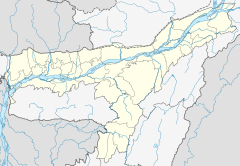Kameng River
Coordinates: 26°38′N 92°53′E / 26.633°N 92.883°E
| Kameng River | |
|---|---|
 Kameng River basin | |
| Physical characteristics | |
| Source | North Arunachal Pradesh |
| • coordinates | 27°55′34″N 92°43′31″E / 27.9261°N 92.7253°E |
| Mouth | Brahmaputra River |
• coordinates | 26°37′55″N 92°52′47″E / 26.6319°N 92.8796°E |
| Basin features | |
| Tributaries | |
| • left | Tenga, Bichom and Dirang Chu |
| • right | Bor Dikarai, Pacha |
The Kameng River (previously named Bharali River, now called Kameng in Arunachal Pradesh and Jiabharali (Jia Bharali) in Assam) in the eastern Himalayan mountains, originates in Tawang district from the glacial lake below snow-capped Gori Chen mountain 27°48′36″N 92°26′38″E / 27.81000°N 92.44389°E,[1] elevation 6,300 metres (20,669 ft),[2][3] on the India-Tibet border and flows through Bhalukpong circle of West Kameng District, Arunachal Pradesh and Sonitpur District of Assam, India. It becomes a braided river in its lower reaches[4] and is one of the major tributaries of the Brahmaputra River, joining it at Tezpur, just east of the Kolia Bhomora Setu bridge.[5]
The Kameng River is about 264 kilometres (164 mi) long. Its drainage basin is about 11,843 square kilometres (4,573 sq mi) large.[6]
The Kameng forms the boundary between East Kamemg District and West Kameng Districts and is also the boundary between the Sessa and Eaglenest sanctuaries to its west and the Pakke tiger reserve to the east.[7] The Dafla Hills are east and the Aka Hills (home of Aka tribe) are west of the Kameng River. The entire stretch of forest along the Bhalukpong–Bomdila highway on the west bank of the river in West Kameng has vanished in the last few years though the forest across the river continues to be in a healthy state.[8]
History[edit]
The Kameng river had an important historical significance. During the medieval period i.e. between 13th to early 16th century, it marked the borders between the Chutiya kingdom and the Kamata kingdom. Later, in the 16th century, after the annexation of the Chutiya kingdom by the Ahoms and the downfall of Kamata kingdom, it acted as the border between the Ahom kingdom and Baro-Bhuyan rule.[citation needed]
Tributaries[edit]
The eastern half of Eaglenest-Sessa Wildlife sanctuaries is drained by the Tippi Naala (Tippi River) which joins Kameng River at the village of Tippi on the Bhalukpong-Bomdila Highway. The other major rivers flowing through West Kameng District, the Tenga, Bichom and Dirang Chu, are tributaries of the Kameng.[9]
Maps[edit]
See also[edit]
Notes[edit]
- ↑ Alpine Club Library - Himalayan Index - Results of Search by latitude/longitude
- ↑ (1997) ThinkQuest team, retrieved 10/1/2007 Kangto Massif Archived 2008-08-28 at the Wayback Machine
- ↑ East Kameng District at a glance, retrieved 9/15/07 Brief History Archived 2003-12-10 at the Wayback Machine
- ↑ Phukon, P.; Machahary, Ratamali (2011). "Bankline Migration of the Jiabharali River, North Brahmaputra Plain, Assam". Geodynamics, sedimenation and biotic response in the context of India-Asia collision. Memoir #77. Bangalore: Geological Society of India. pp. 547–557. ISBN 978-81-907636-2-2.
- ↑ "Eaglenest Biodiversity Project map of Western Arunachal Pradesh". Archived from the original on 18 October 2007. Retrieved 1 October 2007.
- ↑ Rao, K.L. (1979). India's Water Wealth. Orient Blackswan. p. 78. ISBN 978-81-250-0704-3. Retrieved 1 May 2011.
- ↑ Eaglenest Biodiversity Project map of Eaglenest Wildlife Sanctuary Archived 2007-09-18 at the Wayback Machine
- ↑ Athreya, R. (2006) Eaglenest Biodiversity Project − I (2003–2006): Conservation resources for Eaglenest wildlife sanctuary, A report submitted to the Forest Department of the Government of Arunachal Pradesh, India, and the Rufford-Maurice-Laing Foundation (UK). Kaati Trust, Pune. 2.2.2 Geography and Climate, p 23 Archived 2010-06-02 at the Wayback Machine
- ↑ Nandy S.N. District Profile: West Kameng District, G.B. Pant Institute of Himalayan Environment and Development, Kosi-Katarmal, Almora 263643, India


